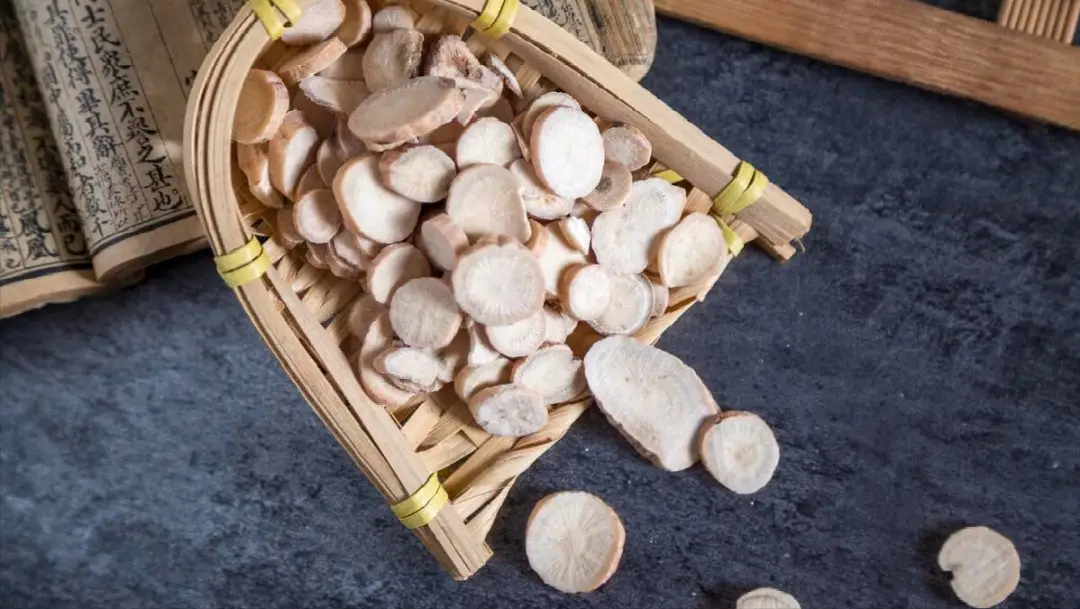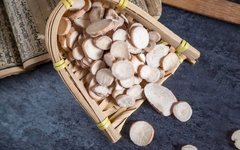The effects, functions, contraindications, and consumption methods of Bai Shao (White Peony). The nutritional value of Bai Shao. How to consume Bai Shao effectively.
Bai Shao is the root of the plant Paeonia lactiflora from the family Ranunculaceae, with the outer skin removed. Bai Shao is also known as Bai Hua Shao (White Flower Peony) and is a traditional medicinal flower in China with a long history of cultivation, renowned both domestically and internationally. Its root is used in medicine. Currently, wild varieties can still be found in areas such as the Qinling and Dabie Mountains. It is mainly produced in provinces such as Shandong, Anhui, Zhejiang, Sichuan, and Guizhou, with cultivation in Northeast China, Hebei, Shanxi, Inner Mongolia, and Shaanxi. Bai Shao can be categorized into three main types based on its production area: those from Zhejiang are called “Hang Shao”, those from Anhui are called “Bo Shao”, and those from Sichuan are called “Chuan Shao”.

Effects of Bai Shao
Functions: Calms the liver, alleviates pain, nourishes the blood.
Nutritional value: Protein, Starch, Sugar.
Suitable for: Individuals with irregular menstruation and dysmenorrhea.
Contraindications: Not suitable for those with deficiency-cold syndrome when used alone.
Functions and Effects of Bai Shao
1. Regulates menstruation: Bai Shao nourishes the blood and astringes yin, treating gynecological disorders, often used in combination with Dang Gui (Angelica Sinensis), Shu Di Huang (Rehmannia), Chuan Xiong (Ligusticum), etc. When used with Gui Zhi (Cinnamon Twig), it can harmonize the defensive and nutritive qi, treating external wind-cold and spontaneous sweating due to deficiency; when combined with Long Gu (Dragon Bone), Mu Li (Oyster Shell), and Fu Xiao Mai (Einkorn Wheat), it can astringe yin and subdue yang, treating spontaneous sweating and night sweats caused by yin deficiency and yang floating.
2. Treats hand and foot spasms: Bai Shao nourishes the blood and softens the liver, alleviating pain, thus can be used for chest and flank pain, abdominal pain, and hand and foot spasms caused by disharmony of liver qi. For flank pain, it is often used with Chai Hu (Bupleurum) and Zhi Ke (Bitter Orange); for abdominal pain and hand and foot spasms, it is often combined with Gan Cao (Licorice); for dysentery-related abdominal pain, it can be used with Huang Lian (Coptis) and Mu Xiang (Aucklandia).
3. Treats dizziness: Raw Bai Shao can astringe yin and pacify liver yang, thus can be used for headaches and dizziness due to excessive liver yang, often combined with Mulberry Leaf, Chrysanthemum, Gou Teng (Uncaria), and Bai Ji Li (Tribulus Terrestris).
4. Beauty and blood nourishment: In TCM theory, Bai Shao has the effect of nourishing the blood, which can treat sallow complexion, facial spots, and lack of luster.
What to pay attention to when consuming Bai Shao?
1. Different processing methods of Bai Shao can produce different effects.
2. Raw Bai Shao has a stronger astringent and liver-calming effect, while fried Bai Shao is better for nourishing blood and liver, often used for those with excessive liver and spleen deficiency pain and diarrhea.
How to select Bai Shao?
The dried root should be cylindrical, uniform in thickness, straight, 10-20 cm long, and 1-1.8 cm in diameter. The surface should be light reddish-brown or pale white, flat, or have obvious longitudinal wrinkles and root hair marks. Areas where the cork has not been completely removed may have brownish spots, and transverse pores may occasionally be seen.
It should be firm and heavy, not easily broken. The cross-section should be grayish-white or slightly brown, with the wood part showing a radiating pattern resembling a chrysanthemum heart. It should be odorless, with a slightly bitter and sour taste. The best quality is characterized by a thick, long, uniform, firm root, with sufficient powdery texture and a clean surface.
How to store Bai Shao?
Store in a cool, dry place, sealed, and protected from pests.

